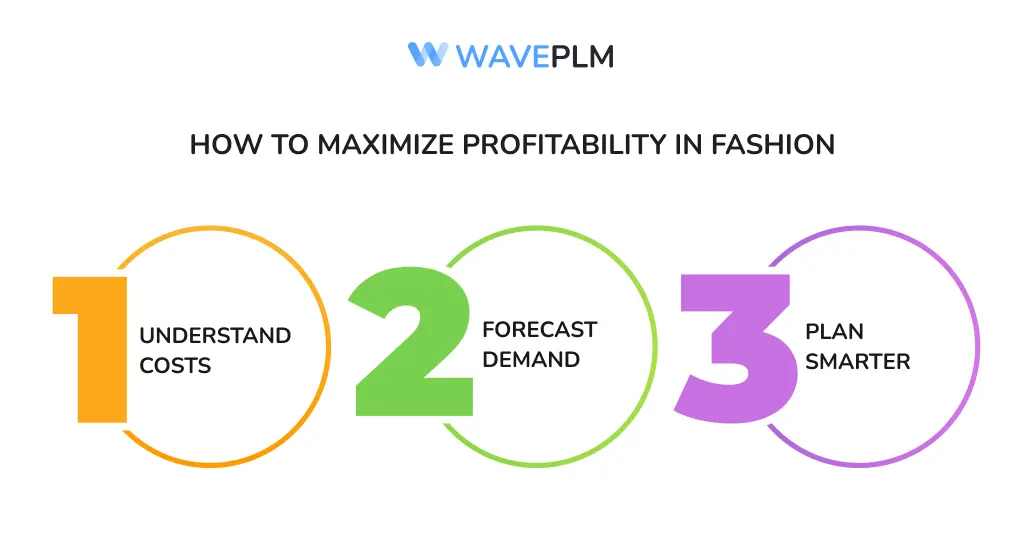
Profitability is the core goal of every fashion brand. Yet, increasing profitability takes more than selling more products. To stay competitive, fashion companies must understand what profitability means, how to improve financial performance, and how tools like PLM software help along the way.
To achieve sustainable success, brands must rethink their approach to planning, pricing, and performance. They must build agility into their operations and rely on data instead of guesswork. This is where smarter product planning comes in. With better planning, fashion businesses can increase profitability while delivering better value to customers and improving the production process.
Let’s explore proven strategies to increase profitability by looking at how brands like Asics and Kroger drive results through smarter planning, better cost control, and faster decision-making.
What is Profitability?
Profitability is the ability of a business to generate profits from its operations. It answers a simple question: does your brand make more money than it spends?
A profitable brand doesn’t just survive—it thrives. Profitability reflects strong financial performance, a healthy cost structure, and the ability to grow sustainably. Understanding your profit margins can help you identify products or services that drain resources, and reveal opportunities to improve pricing, sourcing, or marketing.
Key Profitability Metrics
| Metric | Formula | What It Tells You |
|---|---|---|
| Gross Profit Margin | (Total Revenue – Cost of Goods Sold) / Total Revenue | Shows how well your brand controls production costs |
| Net Profit Margin | Net Profit / Total Revenue | Shows how much profit remains after all costs are covered |
| Operating Profit Margin | Operating Profit / Revenue | Shows how efficiently your brand runs core operations |
Use these metrics regularly to evaluate product lines, seasonal drops, and new market entries. Monitor trends and adjust your pricing or product mix based on profitability—not just popularity.
How to Maximize Profitability in Fashion
Improving profitability does not mean cutting corners. It means working smarter. Brands that optimize profitability do three things well:
- Understand costs
- Forecast demand
- Plan smarter
These actions form the foundation of a more resilient and profitable business. Let’s dive into how you can implement each strategy effectively.

1. Identify Areas That Hurt Profit
Start by reviewing your cost of goods sold (COGS). Break down every component—fabric, trims, labor, packaging, transportation, and duties. Then analyze which elements add the most cost and which can be optimized or sourced more efficiently.
Modern PLM software provides real-time insights into your production process, making it easier to identify problem areas. By visualizing your BOM (Bill of Materials) and cost structures early in the development cycle, you can make better sourcing decisions and avoid margin loss.
Example:
Asics profitability improved when they streamlined their supply chain and reduced excess stock. They used predictive analytics and better forecasting tools to lower warehouse costs, reduce markdowns, and match supply with demand more accurately.
2. Adjust Pricing and Product Mix
Not every product needs to compete on price. Fashion brands can increase prices when they provide unique value. Use customer segmentation to identify high-value buyers who are willing to pay more for personalized, sustainable, or exclusive products.
Cross-selling is another powerful strategy. If a customer buys a winter coat, suggest a matching scarf or gloves. This approach increases total revenue and deepens the customer relationship without raising acquisition costs.
Bundle products that complement each other. Offer curated looks or style guides. This encourages bigger baskets and increases average order value.
3. Optimize the Cost Structure
Use a profitability case for every new collection. This is a quick analysis that helps you understand whether the collection aligns with your financial goals.
Ask these questions:
- Will this product line generate profits or just boost visibility?
- Can the same design be offered in fewer colorways to reduce inventory risk?
- Is the supply chain optimized to minimize waste and shipping costs?
Simplify your offering where possible. Too many SKUs increase complexity and cost. Focus on quality, fit, and seasonality instead of quantity.
4. Improve Financial Performance with PLM
Fashion PLM software brings design, sourcing, and sales teams together into one shared space. It connects data across the entire production process and gives every team access to real-time updates. This collaboration allows faster decision-making and fewer costly errors.
How PLM Helps:
| Area | PLM Benefit |
|---|---|
| Design | Reuse materials and trims to cut costs |
| Sourcing | Compare vendors by price, quality, and lead time |
| Production | Track costs and timelines in real-time |
| Sales | Align inventory levels with real demand forecasts |
| Planning | Create accurate financial models for each collection |
Teams no longer work in silos. Everyone sees the same data. This reduces miscommunication, late deliveries, and expensive design changes.
Real-World Examples: Kroger and Asics Profitability
Kroger Profitability Strategy
Kroger, a major grocery and retail brand, implemented data-driven planning to improve store layouts, streamline operations, and reduce waste. They relied on AI-powered demand forecasting to understand buying behavior in real time.
Fashion brands can take a similar approach. Use tools that track sell-through rates, customer preferences, and channel performance. Adjust stock levels by region, trend, or season to avoid overproduction and markdowns. This results in increased revenue and better control over your net profit margin.
Asics Profitability Case
Asics focused on optimizing their product lifecycle by launching fewer, more relevant styles. They analyzed past performance to develop collections with a higher chance of success. This reduced waste and overstock, while boosting gross profit margins.
By investing in forecasting software and centralizing their product data, Asics improved coordination between product, marketing, and retail teams. The result was better margins and a more agile go-to-market strategy.
PLM Template: Planning for Profitability
Use this simple planning template to make smarter decisions and build profitability into every stage:
| Step | Action | Tool |
|---|---|---|
| 1 | Review past sales by product | Sales reports, PLM dashboards |
| 2 | Check COGS per item | PLM BOM cost breakdown |
| 3 | Forecast demand by segment | AI-based demand planning |
| 4 | Plan mix of high- and mid-margin items | Merchandise planning modules |
| 5 | Track margin across lifecycle | PLM profit tracker and margin alerts |
| 6 | Optimize timing of launches | Seasonal planning and production calendars |
| 7 | Evaluate supplier performance | Vendor scorecards in PLM |
Revisit this checklist at each major milestone. It will help guide your decisions with clarity and consistency.
Strategies to Increase Profitability
Let’s wrap it up with a comprehensive list of actionable tactics you can apply today:
Tactical Checklist
✅ Define what is profitability for your brand (e.g., 60% gross margin goal)
✅ Cut unnecessary product variants and simplify assortments
✅ Reduce time to market with faster reviews and approvals
✅ Use digital samples instead of physical ones to save time and cost
✅ Test pricing strategies with A/B testing across markets or customer segments
✅ Focus on high-performing revenue streams and reduce reliance on low-margin items
✅ Train teams to use PLM for better decisions and collaboration
✅ Adjust pricing to reflect value and market willingness to pay
✅ Improve supplier collaboration with transparent, real-time data
✅ Monitor trends that affect your cost structure or customer behavior
✅ Cross sell and upsell with intention, not guesswork
Why Smarter Planning Drives Profit
When you use PLM and AI-powered forecasting tools, your brand can:
- Make accurate predictions using historical and external data
- Respond quickly to market conditions without overproducing
- Align new collections with real customer demand and feedback
- Control and improve costs at each step of the development cycle
- Strengthen overall profitability through data-driven planning
In fashion, speed is essential—but speed without planning can lead to waste and missed opportunities. The smartest brands build flexibility into their operations and use real-time data to make profitable decisions.

Final Thoughts
Profitability is not a guess. It’s a result of smart planning, reliable tools, and aligned teams.
With the right systems in place—like Wave PLM and integrated planning solutions—you can turn each product into a dependable revenue stream. Use forecasting, margin analysis, and supply chain visibility to your advantage.
Start by identifying where money leaks in your process, then build a roadmap that helps you grow stronger margins across all stages. Profitability becomes easier when you connect product, planning, and performance into one workflow.
Want help building a profitability case for your brand?
Let’s talk.





Leave a Reply